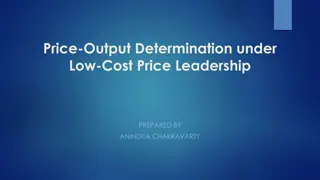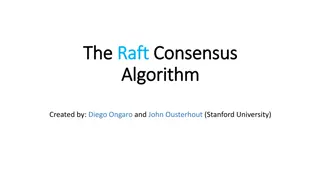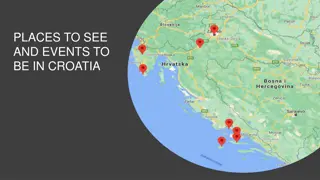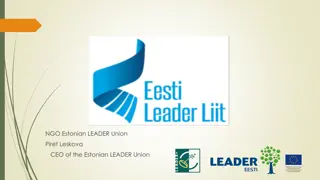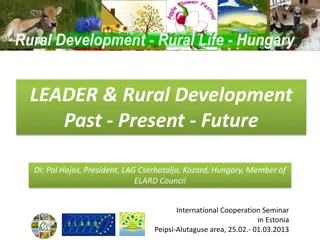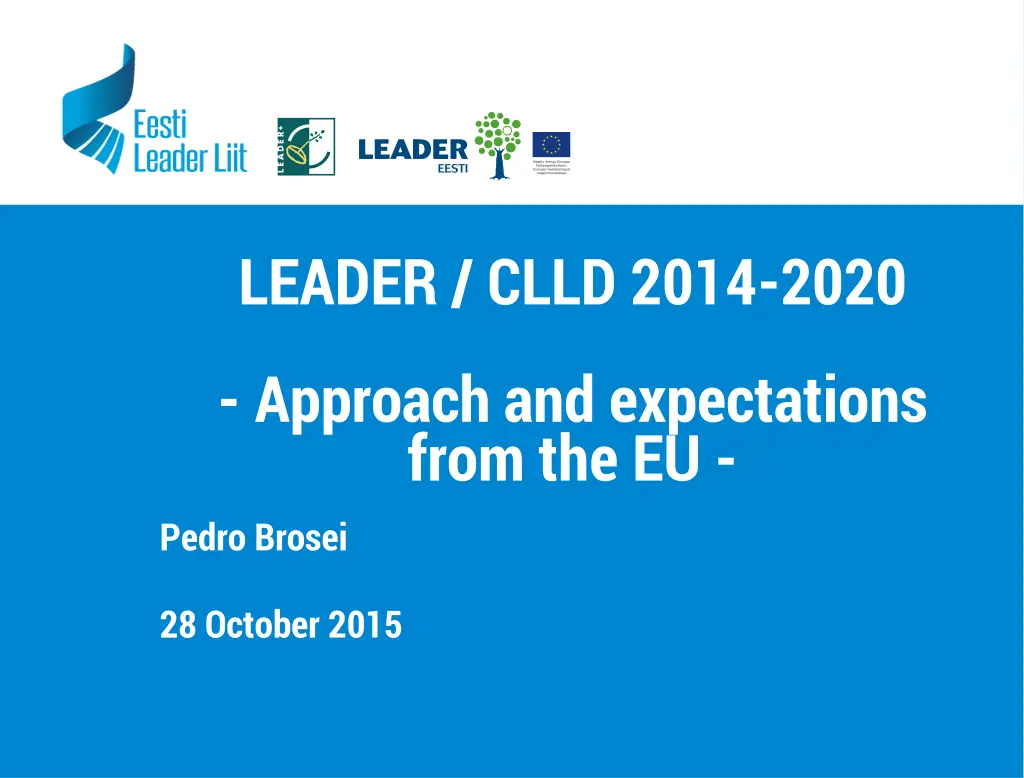
Evolution of Leader Approach in EU: CLLD Expectations & Development Strategies
Explore the evolution of the LEADER approach in the EU, focusing on the added value of CLLD and the community-led local development strategies. Understand the shift from Leader I to Leader/CLLD funds, with a comprehensive overview of the approach and expectations set by the EU for inclusive growth and territorial development.
Download Presentation

Please find below an Image/Link to download the presentation.
The content on the website is provided AS IS for your information and personal use only. It may not be sold, licensed, or shared on other websites without obtaining consent from the author. If you encounter any issues during the download, it is possible that the publisher has removed the file from their server.
You are allowed to download the files provided on this website for personal or commercial use, subject to the condition that they are used lawfully. All files are the property of their respective owners.
The content on the website is provided AS IS for your information and personal use only. It may not be sold, licensed, or shared on other websites without obtaining consent from the author.
E N D
Presentation Transcript
LEADER / CLLD 2014-2020 - Approach and expectations from the EU - Pedro Brosei 28 October 2015
ADDED VALUE OF CLLD Added value of CLLD/LEADER Sub-regional areas -The local territorial approach (Article 32.2.a CPR) R Flexible response to needs E Community led partnerships - Participatory and partnership approaches (Article 32.2.b CPR) Mobilises knowledge, energy and resources S Integrated multi-sectoral local strategies (Article 32.2.c CPR) U Linkages and synergy. Horizontal and vertical L New markets, products, and ways of doing. Social innovation Innovation T (Article 32.2.d CPR) S Networking and cooperation Transfer of good practice, joint solutions to common problems (also Article 32..d CPR)
Evolution of the LEADER approach Leader I (1991-93) experience : following the criticism of the single project approach in the structural policy Leader II (1994-99) laboratory : limited to less favoured rural areas, innovation, pilot actions; introduction of transnational cooperation Leader + (2000-06) maturity phase : eligibility of all rural areas; reinforcement of the role to be played by networks and of transnational cooperation (Leader + type measure for the new Member States 2004- 2006) Integrated Leader (2007-13) Leader axis no specific Leader programmes; Leader as a methodological approach following the general programming of rural development + LEADER under IPARD, + Axis 4 of the EMFF Leader approach as a base for the community-led local development (CLLD) approach carried out by local actors in the 4 ESI-Funds 2014-2020 2
Community-led local development (CLLD) in the new framework Europe 2020 strategy: Territorial development on sub-regional level as a cross-cutting issue for inclusive growth Common Sttrategig Framework for the ESI-Funds addresses CLLD asa toolfor territorial development Partnership Contracts will hadto addressCLLD Common Provisions Regulation for theESI-Funds: offersa common approachto support community-ledlocaldevelopment: singleset ofrules(art. 28-31), which arecomplementedbyfund-specific features(in case ofEAFRD and EMFF).
From LEADER I to LEADER/CLLD Funds EU Budget (EUR) LAGs Leader I 1991-1993 EAGGF-Guidance, ESF, ERDF 450 million 217 Leader II 1994-1999 EAGGF-Guidance, ESF, ERDF 1.7 billion 821 Leader+ 2000-2006 EAGGF-Guidance 2.1 billion 893 in EU-15 (+ 250 under Leader+ type measure 2004- 2006 in 6 NMS) Leader Axis 2007-2013 EAFRD 5.5 billion = 6% of the EAFRD funding Total public: 8.9 billion 2.416 in 27 Member States CLLD Leader 5.0 2014-2020 EAFRD, ESF, ERDF, EMFF EAFRD: +/- 4.5 billion (min. 5% in each RDP) Total public funding in RDPs: 9.4 billion Expected 2.050 LAGs supported by RDPs in 28 Member States 3
Indicative allocation of budget for LEADER 2014-20 (total public) Source: ENRD LEADER sub-group, state of play: April 2015
ESI-Funds supporting CLLD across MS EAFRD, ERDF, ESF and EMFF BG, DE, ES, FR, GR, IT, PL, PT, RO, SE, UK CZ, HU 4 Funds 3 Funds 2 Funds 1 Fund EAFRD, ERDF and ESF 3 EAFRD, ERDF and EMFF SI 11 EAFRD and ERDF AT, SK EAFRD and EMFF CY, DK, EE, FI, HR, IE, LT, LV 11 EAFRD and ESF NL (possibly) 3 EAFRD only BE, LU, MT
Lessons learnt from the past which are reflected in the 2014-20 legal framework Some rigidities in the use of LEADER as driver for CLLD Limited quality of strategies Unclear responsibilities of different involved parties Limited LAG's capacities to develop and implement a Local Development Strategy (LDS) Limited level of participation and limited interest by the private sector
What was the way forward for 2014-2020 ? Strengthening the role of LDS as central tool to meet core objectives at local level, unlocking strategies from RD measures Greater focus on animation and capacity building Strengthening the participation of the private sector in the partnerships Reinforced networking tools for LAGs on EU and national level Streamlined transnational cooperation
High quality local development strategies Analysis of the development needs and potential of the area integrated Objectives, including clear and measurable targets for outputs or results Community involvement in the development of the strategy multi- sectoral Linkages between develop- ment actions networking Action plan Management and monitoring arrangements Financial plan(viable budget) Local innovation cooperation (see Art. 33.1 CPR)
Elaboration of local development strategies -Contributionto programmeobjectives -Coherenceand consistencywith "top- down" orother strategies -Localneeds identified throughSWOT analysis -Bottom-upprocess
The mobilisation of the key actors and building the partnerships Buildon existingexperiencewheneverpossible Encouragebottom-upprocesses Range ofsectors tobeincluded in thepartnerships Clarityon theadministrative and financial capacity as well as the tasks of LAGs Balance between"public" and "private" andthe roleofthe civil society Working procedures, rules and structures for decision-making
Tasks of the LAGs (Art. 34 (3) CPR) a) building the capacity of local actors to develop and implement operations including fostering their project management capabilities; b) drawing up a non-discriminatory and transparent selection procedure and objective criteria for the selection of operations, which avoid conflicts of interest, and ensure that at least 50% of the votes in selection decisions are cast by partners which are not public authorities, andallow selection by written procedure; c) ensuring coherence with the CLLD strategy when selecting operations, by prioritising those operations according to their contribution to meeting that strategy's objectives and targets; d) preparing and publishing calls for proposals or establishing an ongoing project submission procedure, including defining selection criteria; e) receiving and assessing applications for support; f) selecting operations andfixing the amount of support and, where relevant, presenting the proposals to the body responsible for final verification ofeligibility before approval; g) monitoring the implementation of the CLLD strategy and the operations supported, and carrying out specific evaluation activities linked to that strategy.
Selection of local development strategies: an effective process Timing: Oneor severalselection rounds Typesofcalls dependingon the readinessofLAGs Selection criteria have to reflect the added value of the CLLD approach Strategies should compete against a common standard rather than against each other Selectioncommittee: Administrative arrangementsin case ofmulti-funding Overall coordinationoftheselectionprocess
How to ensure a more efficient use of LEADER/CLLD? Support capacity-building at all implementation levels Raise awareness of specificities of CLLD for all players involved in CLLD: MAs, Pas, Audit Authorities, LAGs/ project promoters Clear division of responsibilities, avoid duplication Reduce administrative burden for all Simplify procedures for public co-financing Simplified procedures for small projects Simplified cost options (small projects, running costs, etc.) Speed of overall approval process and payments Encourage advance payments (to LAGs and beneficiaries) Keep additional rules to necessary minimum Avoid restrictions of eligibility which limits the capacity of the LAGs to respond to local needs and support innovation Evaluate efficiency of delivery systems
Thank you for your attention!
Advantages of the common CLLD approach Common approach for local development under all European Structural and Investment Funds (ESIF): fosters integrated regional development Harmonized rules for planning and implementation "Multi-Fund" LEADER-strategies enable a contribution of the different related EU policies to reach regional/local ERDF Rural area EAFRD ESF Added value for rural areas: more comprehensive strategies and LAG- partnerships, improvement or rural- urban relationships, synergies with the groups of the fisheries' areas. 17
Member States with CLLD possible also in urban areas







